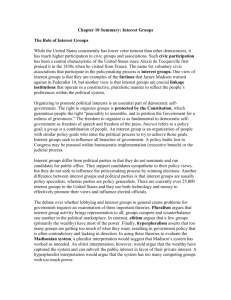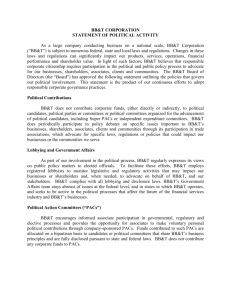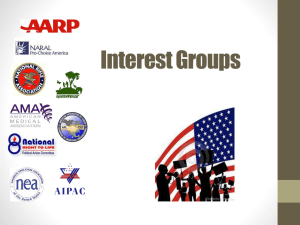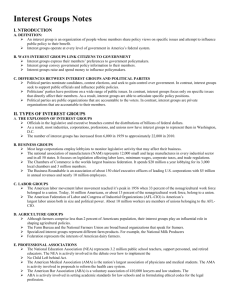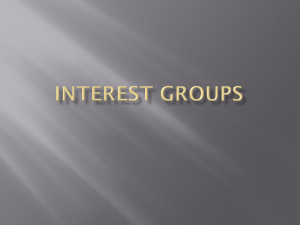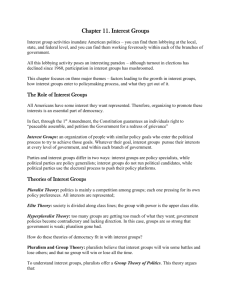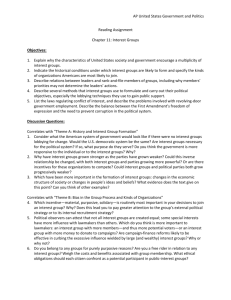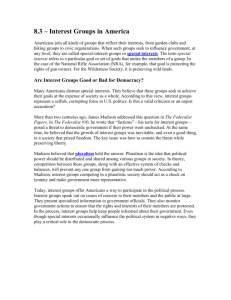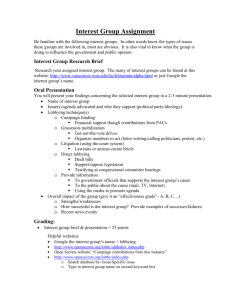Interest Groups
advertisement
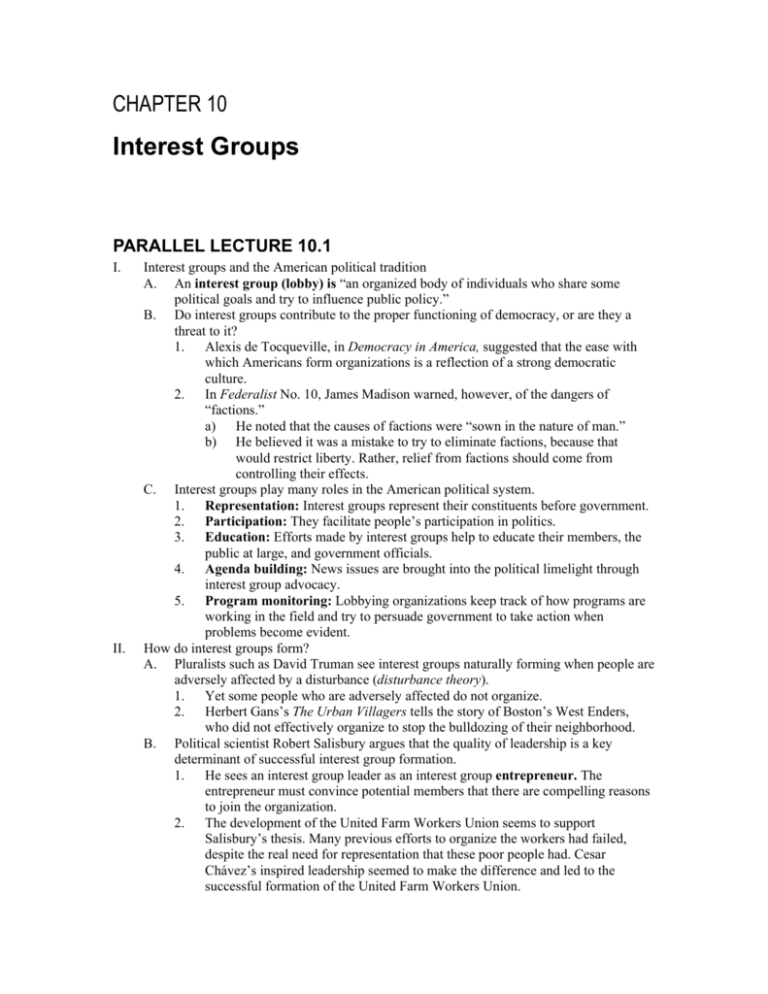
CHAPTER 10 Interest Groups PARALLEL LECTURE 10.1 I. II. Interest groups and the American political tradition A. An interest group (lobby) is “an organized body of individuals who share some political goals and try to influence public policy.” B. Do interest groups contribute to the proper functioning of democracy, or are they a threat to it? 1. Alexis de Tocqueville, in Democracy in America, suggested that the ease with which Americans form organizations is a reflection of a strong democratic culture. 2. In Federalist No. 10, James Madison warned, however, of the dangers of “factions.” a) He noted that the causes of factions were “sown in the nature of man.” b) He believed it was a mistake to try to eliminate factions, because that would restrict liberty. Rather, relief from factions should come from controlling their effects. C. Interest groups play many roles in the American political system. 1. Representation: Interest groups represent their constituents before government. 2. Participation: They facilitate people’s participation in politics. 3. Education: Efforts made by interest groups help to educate their members, the public at large, and government officials. 4. Agenda building: News issues are brought into the political limelight through interest group advocacy. 5. Program monitoring: Lobbying organizations keep track of how programs are working in the field and try to persuade government to take action when problems become evident. How do interest groups form? A. Pluralists such as David Truman see interest groups naturally forming when people are adversely affected by a disturbance (disturbance theory). 1. Yet some people who are adversely affected do not organize. 2. Herbert Gans’s The Urban Villagers tells the story of Boston’s West Enders, who did not effectively organize to stop the bulldozing of their neighborhood. B. Political scientist Robert Salisbury argues that the quality of leadership is a key determinant of successful interest group formation. 1. He sees an interest group leader as an interest group entrepreneur. The entrepreneur must convince potential members that there are compelling reasons to join the organization. 2. The development of the United Farm Workers Union seems to support Salisbury’s thesis. Many previous efforts to organize the workers had failed, despite the real need for representation that these poor people had. Cesar Chávez’s inspired leadership seemed to make the difference and led to the successful formation of the United Farm Workers Union. C. Who is being organized is also an important force affecting group formation. The wealthy and the well-educated are more likely to form and join lobbies. D. Summing it up, three variables explain why groups may or may not become wellorganized: 1. An adverse change or disturbance 2. The quality of leadership 3. The socioeconomic level of potential members III. What resources are available to interest groups? Members, lobbyists, and money. A. One of the most valuable resources a group can have is a large and politically active membership. 1. Business, professional, and trade associations have an easier time holding onto members than citizens groups do. 2. A citizen group must rely largely on ideological appeals. 3. All membership groups are constantly looking for new members. The methods they use: a) Direct mail. Its drawbacks: cost and low rate of return. b) The Internet. 4. One problem interest groups have in attracting members is the free-rider problem. Nonmembers can obtain the public policy benefits of the organization’s lobbying even though they pay no dues. 5. Many people join interest groups anyway. Some join for the selective (nonpolitical) benefits or because they realize that if everyone decides to “let George do it,” it won’t get done. B. Lobbyists can be either full-time employees of the organization or hired from law firms or public relations firms. 1. The typical interaction between a lobbyist and a policymaker is the transmission of information from the lobbyist to the official. 2. What the lobbyist is trying to do is to convince the policymaker that the lobbyist’s data are accurate and deserve more attention than those presented by opposing lobbyists. C. Political action committees (PACs) pool contributions from group members and donate those funds to candidates for office. (See text Figure 10.3.) 1. Two types of PACs have shown the greatest growth in numbers. a) Corporate PACs. b) Nonconnected PACs (ideological PACs formed solely for channeling funds). 2. For most PACs, the primary goal of their contributions is to gain access to incumbents. 3. The role of PACs in financing elections has become the most controversial aspect of interest group politics. a) Critics charge that the money contributed leads to influence and that in a democracy influence should not be tied to money. b) Defenders argue that PACs are a way people can participate in politics. IV. Lobbying tactics A. In direct lobbying, a group’s representatives have direct contact with a policymaker. 1. Lobbyists make personal presentations to officials. 2. Testifying before committees is another direct tactic. 3. Organizations may go to court and litigate. B. In grassroots lobbying, an interest group’s rank-and-file members, and possibly others outside the organization, try to influence government on some issue. 1. Letter writing is one such tactic. 2. Political protests are sometimes held, but it is hard for a group to rely on such action because it is difficult to sustain the anger and energy of large numbers of participants. C. Information campaigns are organized efforts to gain public backing by bringing the group’s views to the public’s attention. 1. Public relations may involve advertising in newspapers (which is very expensive), sending speakers to meetings, or disseminating pamphlets or fact sheets. 2. Sponsoring research is another way interest groups press their cases. 3. Some groups publicize the voting records of Congress. Some publish indexes of how members of Congress voted on issues of critical importance to the group. D. Many lobbyists have added a range of high-tech techniques to their repertoire. 1. Lobbies use technologies like e-mail, polling, and the World Wide Web to expand their reach. 2. High-tech lobbying has sped up the political process; groups can quickly mobilize their constituents, who can then quickly contact policymakers about impending decisions. 3. The Web has also allowed people to organize who might not otherwise be able to contact each other easily. E. Coalition building takes place when several groups join together in a lobbying campaign. V. Is the system biased? A. Lobbying can be evaluated through both the pluralist and majoritarian frameworks. 1. Evaluating fairness in the pluralist framework requires that we take account of two criteria. a) Significant interests in the population should be adequately represented. b) Government should listen to the views of all major interests. The benefits of majoritarianism are built into our political system: since elections are majoritarian, the party in power tends to have more to say in policymaking. 2. Membership bias is unmistakable as some sectors of society are much better represented than others a) The middle and upper middle classes are far better represented by organized interest groups than are others. b) This does not mean, however, that the interest group system is unmistakably biased; citizen groups (e.g., the Food Research and Action Committee and the Children’s Defense Fund) represent the interests of policies that impact poor people. c) The increase in the number of business lobbies in the 1970s and 1980s further aggravates the imbalance; data shows that business has an advantage in the interest group system. .VI. Reform A. It is difficult to put limits on interest groups without limiting fundamental freedoms. B. PAC contributions are particularly problematic. 1. Agreement is widespread that PAC donations give donors better access to members of Congress. 2. Congress has required disclosure of all campaign contributions so the sources can be identified. C. Reformers have called for reducing the role of PACs in financing elections. 1. The controversy over PACs reflects the tension between the principles of freedom and equality. 2. 3. Critics charge that PACs reinforce, if not expand, the inequities between rich and poor. PAC supporters counter that people should have the right to join with others who think as they do and support the candidates of their choice.

